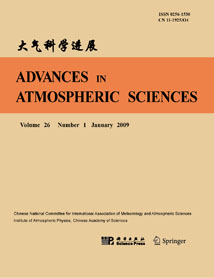| [1] |
CHEN Hong, LIN Zhaohui,
2006: A Correction Method Suitable for Dynamical Seasonal Prediction, ADVANCES IN ATMOSPHERIC SCIENCES, 23, 425-430.
doi: 10.1007/s00376-006-0425-3
|
| [2] |
LIN Zhaohui, WANG Huijun, ZHOU Guangqing, CHEN Hong, LANG Xianmei, ZHAO Yan, ZENG Qingcun,
2004: Recent Advances in Dynamical Extra-Seasonal to Annual Climate Prediction at IAP/CAS, ADVANCES IN ATMOSPHERIC SCIENCES, 21, 456-466.
doi: 10.1007/BF02915572
|
| [3] |
Liu Jinli, Xiao Jianming, Zhang Ling,
1990: The Investigation of Microwave Precipitation Measurement at 37GHz, ADVANCES IN ATMOSPHERIC SCIENCES, 7, 104-110.
doi: 10.1007/BF02919173
|
| [4] |
Dong-Kyou LEE, William J. GUTOWSKI, Jr., Hyun-Suk KANG, Chun-Ji KIM,
2007: Intercomparison of Precipitation Simulated by Regional Climate Models over East Asia in 1997 and 1998, ADVANCES IN ATMOSPHERIC SCIENCES, 24, 539-554.
doi: 10.1007/s00376-007-0539-2
|
| [5] |
Xiaoling YANG, Botao ZHOU, Ying XU, Zhenyu HAN,
2021: CMIP6 Evaluation and Projection of Temperature and Precipitation over China, ADVANCES IN ATMOSPHERIC SCIENCES, 38, 817-830.
doi: 10.1007/s00376-021-0351-4
|
| [6] |
Saleh AMINYAVARI, Bahram SAGHAFIAN, Majid DELAVAR,
2018: Evaluation of TIGGE Ensemble Forecasts of Precipitation in Distinct Climate Regions in Iran, ADVANCES IN ATMOSPHERIC SCIENCES, 35, 457-468.
doi: 10.1007/s00376-017-7082-6
|
| [7] |
WANG Gaili, LIU Liping, DING Yuanyuan,
2012: Improvement of Radar Quantitative Precipitation Estimation Based on Real-Time Adjustments to Z--R Relationships and Inverse Distance Weighting Correction Schemes, ADVANCES IN ATMOSPHERIC SCIENCES, 29, 575-584.
doi: 10.1007/s00376-011-1139-8
|
| [8] |
XUE Haile, SHEN Xueshun, CHOU Jifan,
2015: An Online Model Correction Method Based on an Inverse Problem: Part II——Systematic Model Error Correction, ADVANCES IN ATMOSPHERIC SCIENCES, 32, 1493-1503.
doi: 10.1007/s00376-015-4262-0
|
| [9] |
Lei HAN, Mingxuan CHEN, Kangkai CHEN, Haonan CHEN, Yanbiao ZHANG, Bing LU, Linye SONG, Rui QIN,
2021: A Deep Learning Method for Bias Correction of ECMWF 24–240 h Forecasts, ADVANCES IN ATMOSPHERIC SCIENCES, 38, 1444-1459.
doi: 10.1007/s00376-021-0215-y
|
| [10] |
CHENG Xinghong, SU Debin, LI Deping, CHEN Lu, XU Wenjing, YANG Meilin, LI Yongcheng, YUE Zhizhong, WANG Zijing,
2014: An Improved Method for Correction of Air Temperature Measured Using Different Radiation Shields, ADVANCES IN ATMOSPHERIC SCIENCES, 31, 1460-1468.
doi: 10.1007/s00376-014-3129-0
|
| [11] |
Xiaoxu TIAN, Xiaolei ZOU, Shengpeng YANG,
2018: A Limb Correction Method for the Microwave Temperature Sounder 2 and Its Applications, ADVANCES IN ATMOSPHERIC SCIENCES, 35, 1547-1552.
doi: 10.1007/s00376-018-8092-8
|
| [12] |
Jeong-Eun LEE, Sung-Hwa JUNG, Hong-Mok PARK, Soohyun KWON, Pay-Liam LIN, GyuWon LEE,
2015: Classification of Precipitation Types Using Fall Velocity-Diameter Relationships from 2D-Video Distrometer Measurements, ADVANCES IN ATMOSPHERIC SCIENCES, 32, 1277-1290.
doi: 10.1007/s00376-015-4234-4
|
| [13] |
Chengcheng NI, Guoping LI, Xiaozhen XIONG,
2017: Analysis of a Vortex Precipitation Event over Southwest China Using AIRS and In Situ Measurements, ADVANCES IN ATMOSPHERIC SCIENCES, 34, 559-570.
doi: 10.1007/s00376-016-5262-4
|
| [14] |
MIAO Qun, and Bart GEERTS,
2013: Airborne measurements of the impact of ground-based glaciogenic cloud seeding on orographic precipitation, ADVANCES IN ATMOSPHERIC SCIENCES, 30, 1025-1038.
doi: 10.1007/s00376-012-2128-2
|
| [15] |
Xiaoling YANG, Botao ZHOU, Ying XU, Zhenyu HAN,
2023: CMIP6 Evaluation and Projection of Precipitation over Northern China: Further Investigation, ADVANCES IN ATMOSPHERIC SCIENCES, 40, 587-600.
doi: 10.1007/s00376-022-2092-4
|
| [16] |
XUE Hai-Le, SHEN Xue-Shun, CHOU Ji-Fan,
2013: A Forecast Error Correction Method in Numerical Weather Prediction by Using Recent Multiple-time Evolution Data, ADVANCES IN ATMOSPHERIC SCIENCES, 30, 1249-1259.
doi: 10.1007/s00376-013-2274-1
|
| [17] |
XUE Haile, SHEN Xueshun, CHOU Jifan,
2015: An Online Model Correction Method Based on an Inverse Problem: Part I——Model Error Estimation by Iteration, ADVANCES IN ATMOSPHERIC SCIENCES, 32, 1329-1340.
doi: 10.1007/s00376-015-4261-1
|
| [18] |
Hongli LI, Xiangde XU,
2017: Application of a Three-dimensional Variational Method for Radar Reflectivity Data Correction in a Mudslide-inducing Rainstorm Simulation, ADVANCES IN ATMOSPHERIC SCIENCES, 34, 469-481.
doi: 10.1007/s00376-016-6010-5
|
| [19] |
CHEN Hua, GUO Jing, XIONG Wei, GUO Shenglian, Chong-Yu XU,
2010: Downscaling GCMs Using the Smooth Support Vector Machine Method to Predict Daily Precipitation in the Hanjiang Basin, ADVANCES IN ATMOSPHERIC SCIENCES, 27, 274-284.
doi: 10.1007/s00376-009-8071-1
|
| [20] |
JIE Weihua, WU Tongwen, WANG Jun, LI Weijing, LIU Xiangwen,
2014: Improvement of 6-15 Day Precipitation Forecasts Using a Time-Lagged Ensemble Method, ADVANCES IN ATMOSPHERIC SCIENCES, 31, 293-304.
doi: 10.1007/s00376-013-3037-8
|















 AAS Website
AAS Website 
 AAS WeChat
AAS WeChat 
 DownLoad:
DownLoad: